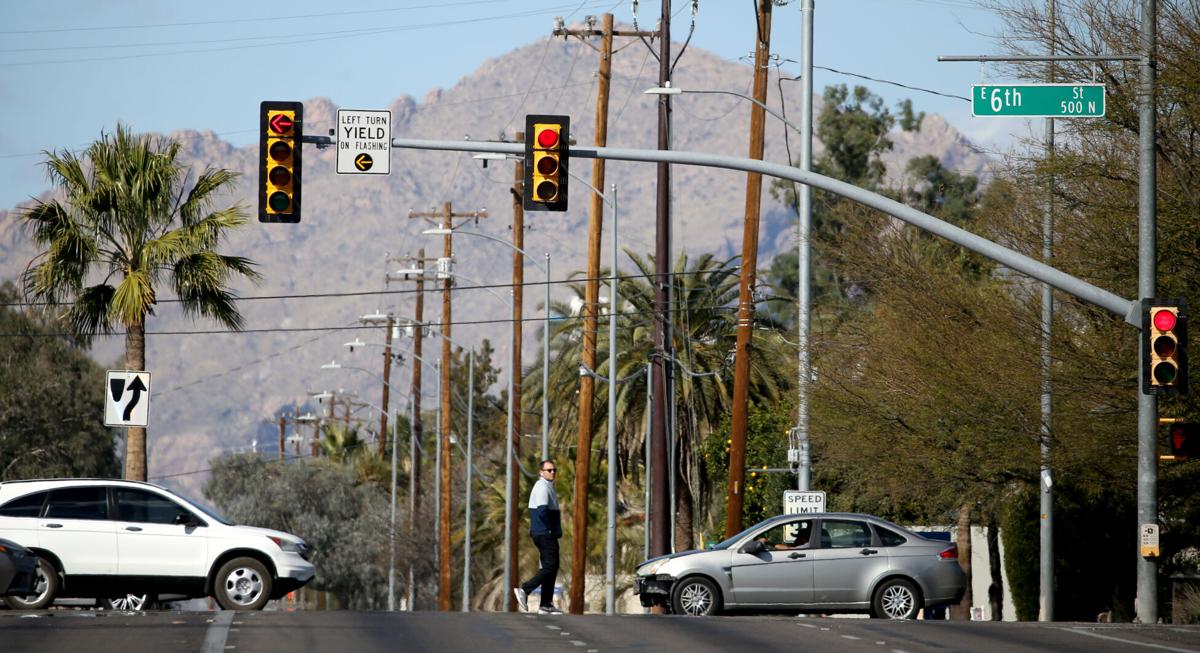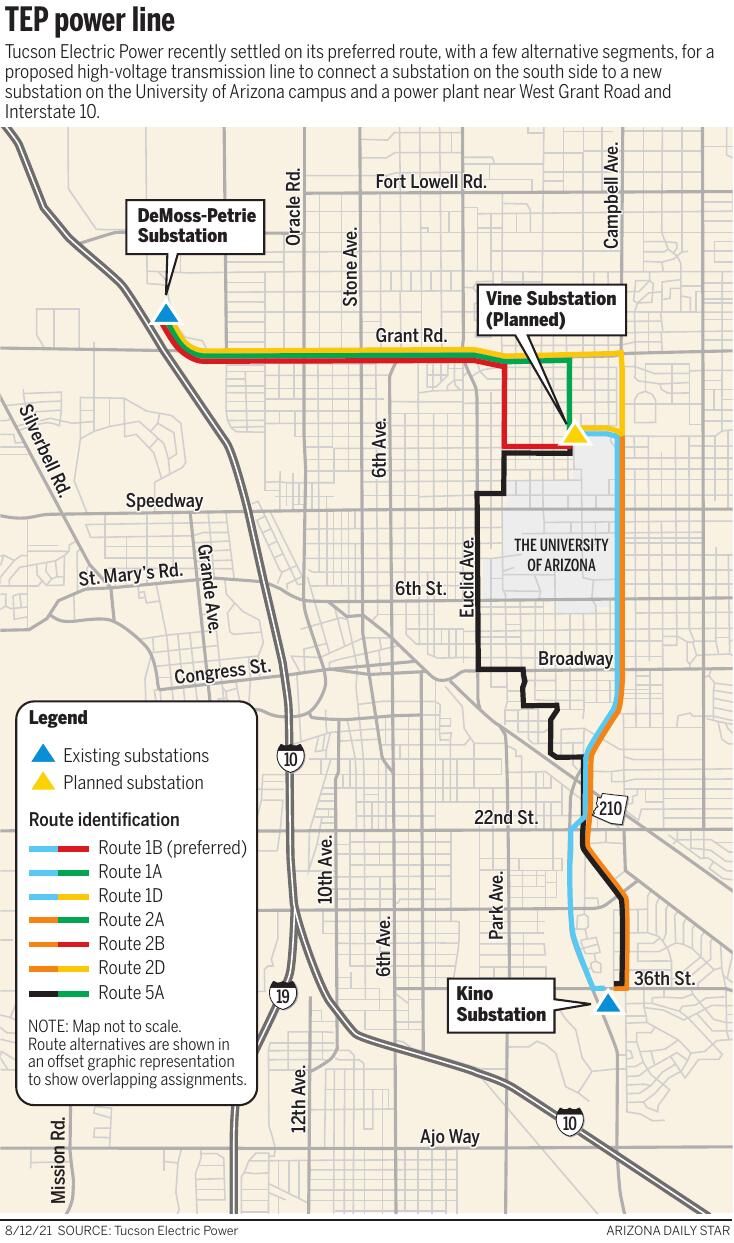A controversial plan by Tucson Electric Power to run high-voltage overhead transmission lines through much of central Tucson has been put on hold to allow more time for negotiations with the city and other stakeholders.
But so far, there has been no new plan to address concerns over the Kino to DeMoss-Petrie transmission line project, much of which would run up the east edge of the University of Arizona campus along North Campbell Avenue and through or adjacent to several historic Tucson neighborhoods.
At TEP’s request, the Arizona Power Plant and Transmission Line Siting Committee postponed a scheduled Feb. 7 meeting on the new power line and allowed the utility to withdraw its application and resubmit a new one by late May, ahead of a line-siting committee meeting on the matter now set for July 25.
If the line-siting committee approves the plan, it will issue a certificate of environmental compatibility that will be forwarded to the Arizona Corporation Commission for final consideration.
In its request to withdraw its original August 2021 filing, TEP says it has been engaged in “productive conversations” on the power line with the city of Tucson and other stakeholders and will likely be filing a modified application based on those discussions.
TEP spokesman Joe Barrios said those talks are ongoing as TEP planning staff meet with city officials, neighborhood groups and commercial customers, and senior TEP leaders meet regularly with city officials.
City Councilman Steve Kozachik said to install overhead lines, TEP will have to apply to the council for “special exception” land-use permits to exempt the project from the city’s Gateway Corridor and Scenic Corridor ordinances, which require underground utilities in areas including North Campbell Avenue.
In May 2021, a city zoning examiner denied TEP’s request for a permit for the Vine Substation on the UA campus, citing a lack of information on the proposed line’s compliance with area development plans.
Barrios said TEP is exploring possible use of the special-exception process to allow for overhead construction along gateway corridors in certain circumstances.
That process requires early public notice, a neighborhood meeting prior to application submittal, a public comment period, review and recommendation by the city’s Planning and Zoning Director and a public hearing before final consideration and approval by the city’s zoning examiner.
TEP says it expects to schedule a public meeting in March, when it plans to provide an update on the location of the preferred route and outline possible special exceptions to the city ordinances.
TEP’s preferred route for the 138,000-volt transmission line would from a substation at South Kino Parkway and East 36th Street and run along the east side of the University of Arizona campus and north up North Campbell Avenue to reach a planned new substation on the northwest side of Banner-University Medical Center Tucson, before zigzagging north to West Grant Road.
‘Intrusive’ poles, lines
The project will feature power poles roughly every 650 feet, generally ranging from rom 75 feet to 93 feet tall, with a few poles as tall as 120 feet, the utility says.
TEP says the power line and substation project is needed to boost power capacity and improve reliability, and to tie into the UA and Banner-UMC to meet growing demand and serve 100% renewable energy to the campus.
But the plan has drawn stiff opposition from residents of Sam Hughes and other historic neighborhoods.
TEP’s preferred route along North Campbell would run along the edges of the Sam Hughes and Blenman Elm neighborhoods, and the route leading west from the planned Vine Substation would cut through the Jefferson Park neighborhood.
“We feel very strongly that these line and poles are very intrusive, they have no business running them through the city, and we are in favor of undergrounding them,” said Colleen Nichols, executive vice president of the Jefferson Park Neighborhood Association.
She said neighborhoods not directly in the path of the transmission line should be concerned about overriding the Gateway and Scenic Corridor ordinances.
“Most neighborhoods do not want huge power poles running through their neighborhood. Our goal is to have all the neighborhoods working together to support undergrounding,” said Nichols, who sits on a steering committee for a coalition of about a dozen neighborhoods that support that goal.
Neighborhood leaders say properties along the line could suffer devaluation of $5 million to $10 million per mile if the overhead lines go in.
TEP says it has buried lower-voltage power distribution lines when property owners have paid for it but has never undergrounded high-voltage transmission lines because of the high cost of installation and maintenance.
“It simply costs more to build and maintain a transmission line underground than overhead,” Barrios said. “Although we recognize stakeholders’ concerns and are working toward a mutually beneficial resolution, we remain concerned that underground construction would increase the costs passed along to customers.”
Meanwhile, about a dozen Tucson neighborhood associations including Jefferson Park, Sam Hughes, West University and Rincon Heights have formed a group called the Underground Coalition to urge TEP to bury the new power lines to protect the neighborhoods.
But TEP says burying the high-voltage lines would be too expensive, estimating the extra cost of undergrounding the entire line at up to $63 million.
TEP says it is willing to install the lines underground to address the city’s and neighborhoods’ concerns, but it opposes passing those costs along to ratepayers and has suggested instead that the city back a special tax district to pay for the excess costs.
Who pays?
Kozachik said the next step is to nail down the cost of “undergrounding” the transmission line, noting that some opponents have questioned TEP’s cost estimate as unreasonably high.
Kozachik said undergrounding only parts of the line could significantly cut the cost, but that still leaves the question of funding for the extra costs.
“I think irrespective of what that final number winds up being, there has to be a conversation about the elephant in the room — who pays?” Kozachik said.
Kozachik says forming a special taxing district to pay for undergrounding the line isn’t feasible and that TEP essentially ignored the city ordinances as it moved forward with its plans and launched public meetings in 2019.
Whether city taxpayers or TEP ratepayers, or both, cover the cost of undergrounding, the line may become a contentious legal issue, he said, noting that the city has clear zoning authority while the Corporation Commission has authority over utility rates.
“We’re exploring various mechanisms to fund the additional costs for undergrounding,” TEP’s Barrios said.
Retired UA political-science professor John Schwarz, a member of the Underground Tucson steering committee, said there well may be diverse sources of funding but TEP can easily absorb the cost through rates.
“That’s the irony of it — if they put it overhead, it may be that Tucsonans end up paying the cost in terms of property devaluations that is as much as it costs to underground it,” said Schwarz, who lives several miles from the proposed transmission line route but considers it a citywide issue.
Any special exceptions to the scenic and gateway corridor ordinance should be considered carefully to preserve the spirit of the ordinances, Schwarz said.
“There are probably places where agreement could be reached, for example places that have industrial buildings already, but our view is the routes should remain scenic,” he said.
Schwarz noted that that the cost of undergrounding the line would be amortized over decades and even at a price tag of $60 million would cost each TEP customer about 20 cents per month.
Asked about the prospect of assembling different funding sources to pay for the extra cost of undergrounding the line, Kozachik said funding could come from TEP ratepayers along with other sources, like federal infrastructure grants, and stakeholders including the UA.
The problem requires an “all hands on deck” solution by all stakeholders, he said.
“It’s probably reasonable to have a conversation about multiple, different funding sources in this case, because it will be a big (cost) number,” Kozachik said, adding that TEP’s cost for undergrounding would be negligible as it is spread across its entire rate base.
But as major beneficiaries of the new transmission line, the UA and hospital partner Banner Health should consider paying a share of the undergrounding costs, he added.
“Banner is a private, for-profit company, the university has access to significant funds, and they are the real driver of this, so both of them ought to be willing to open their checkbooks and say, ‘you know, we’re going to part of the solution as well,’” Kozachik said, adding that the city for its part could seek available federal infrastructure funding.
The UA’s top facilities manager said the new transmission line is badly needed to replace aging equipment and increase capacity not only for the campus, but for the surrounding community.
Chris Kopach noted that the planned new 138kv line would replace a 1960s-era, 46kv substation at the north end of the campus that serves the entire north campus area as well as nearby homes.
The UA north campus and surrounding neighborhoods have been subject to about a half-dozen major blackouts, as recently as last summer’s monsoons in July and August, he noted.
The UA has been supportive of TEP’s project and involved in planning discussion for the new line from the start and plans to be part of that process as it moves forward, Kopach said.
At this juncture, the UA wants to see TEP’s updated plans and consider TEP’s funding options, Kopach said, noting that the UA is still trying to catch up on its own deferred maintenance on its power systems and the pandemic only exacerbated a shortage of funds.
“There’s just a lot of planning, a lot of details that need to be worked out,” Kopach said. “At the U of A, we want to be good partners, but who covers the cost? The U of A’s financial challenges have been well-noted during the pandemic here.”






